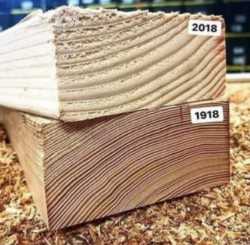>>15377552older trees that grew on natural soil have thinner growth rings, because they grow a steady small amount every year. despite growing less every year on natural soil, they are stronger than modern trees planted by humans. modern trees grow on unnatural soil covered in fertilizers, herbicides and pesticides. they grow faster every year, but get cut down after only a few years. they have less growth rings and are weaker trees, lower quality wood. the older trees that grew on natural soil also had more minerals and tended to be much taller, as they had to compete with other trees of different species and the ones that survived tended to expand both in radius and height to get more sunlight. These were the big trees that survived multiple forest fires, parasite attacks, insects making holes inside them and everything else. Strong, natural trees, with multiple thin but highly mineralised growth rings. Modern tree farms focus only on making trees grow thick as fast as possible, using unnatural means. While they do use fertilizers on the soil, the trees end up forming a very starchy, white and soft growth rings, as opposed to the darker "tree bone" growth rings with thin starchy rings. The positive side I guess is that you can make soup with the modern starchy trees and it would probably be as nutritious as potato soup. Negative side is that modern trees from farms produce brittle, weak, white wood, also known as soft wood. even modern "hardwood trees" from tree farms feel like softwood trees, when compared to older hardwood trees of the same species.

